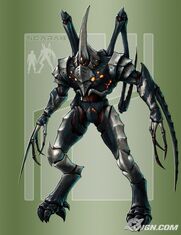No edit summary |
mNo edit summary |
||
| Line 1: | Line 1: | ||
[[File:Scarab.jpg|thumb|181px|Scarab concept art.]] |
[[File:Scarab.jpg|thumb|181px|Scarab concept art.]] |
||
| − | '''Scarabs''' are the most powerful group of [[Drudge|The Drudge]] infantry, and second most powerful of all the Drudge, exceeded only by the massive, tank-like [[Invaders]].<ref name="manual">[http://wii.ign.com/dor/objects/14248157/the-conduit/images/the-conduit-20080620002225828.html?page=mediaFull The Conduit Manual]</ref> Standing approximately 8 feet tall, their extremely resistant exo-skeletons and rapid-fire, explosive-launching [[Hive Cannon|Hive Cannons]] make them far more powerful than any human infantry. Heavily armored, Scarabs can take almost a full magazine of weapons fire before dying. Scarabs come in three different varieties: the standard Scarab, the Storm Scarab, and the alternate Scarab seen in stasis in The Trust Base. |
+ | '''Scarabs''' are the most powerful group of [[Drudge|The Drudge]] infantry, and second most powerful of all the Drudge, exceeded only by the massive, tank-like [[Invaders]].<ref name="manual">[http://wii.ign.com/dor/objects/14248157/the-conduit/images/the-conduit-20080620002225828.html?page=mediaFull The Conduit Manual]</ref> Standing approximately 8 feet tall, their extremely resistant exo-skeletons and rapid-fire, explosive-launching [[Hive Cannon|Hive Cannons]] make them far more powerful than any human infantry. Heavily armored, Scarabs can take almost a full magazine or more of weapons fire before dying. Scarabs come in three different varieties: the standard Scarab, the Storm Scarab, and the alternate Scarab seen in stasis in The Trust Base. |
The standard Scarab is silver-blue and carries a Hive Cannon. These emerge from [[conduits]], and move rather slowly, stomping as they walk. Even though they're slow, the fully-automatic Hive Cannon makes very dangerous. |
The standard Scarab is silver-blue and carries a Hive Cannon. These emerge from [[conduits]], and move rather slowly, stomping as they walk. Even though they're slow, the fully-automatic Hive Cannon makes very dangerous. |
||
Revision as of 07:55, 30 July 2009

Scarab concept art.
Scarabs are the most powerful group of The Drudge infantry, and second most powerful of all the Drudge, exceeded only by the massive, tank-like Invaders.[1] Standing approximately 8 feet tall, their extremely resistant exo-skeletons and rapid-fire, explosive-launching Hive Cannons make them far more powerful than any human infantry. Heavily armored, Scarabs can take almost a full magazine or more of weapons fire before dying. Scarabs come in three different varieties: the standard Scarab, the Storm Scarab, and the alternate Scarab seen in stasis in The Trust Base.
The standard Scarab is silver-blue and carries a Hive Cannon. These emerge from conduits, and move rather slowly, stomping as they walk. Even though they're slow, the fully-automatic Hive Cannon makes very dangerous.
The Storm Scarab is a faster, gray, cloaked version. They are semi-visible, transparent, and untangible. If the player shoots them from a distance, the shots will go through them. The ASE is required to make them completely visible and tangible.
The third version of the Scarab is a brown, less bulky version, with appendages on its shoulders and neck. These Scarabs are the creatures seen in stasis in the final mission Closure, in The Trust Base. In the final mission, Micheal Ford opens the stasis tubes to gain energy to open a conduit so he could exit the Trust Base. Everytime he opens one of these tubes, these Scarabs are released. They carry a Hive Cannon, and walk the same speed as standard Scarabs.
Trivia:
- Prometheus' form is that of the Scarabs in stasis.
- When Storm Scarabs are released, either by conduit or chamber, they will always immediately run towards you, making fights with multiple Storm Scarabs relatively difficult.
- Scarabs can be compared to the Elite Pirates in Metroid Prime, as they are both large units of an enemy alien faction, and are many times seen in and are fought after release from stasis.
